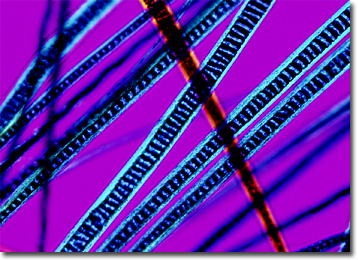Polarized Light Microscopy Digital Image Gallery
Mole Hair
Although a variety of animals are sometimes referred to as moles, true moles are members of the family Talpidae of the mammalian order Insectivora. These small, burrowing animals infamous for the tunneling mounds they leave behind in their wake are native to temperate portions of the Northern Hemisphere.

View a second image of Mole Hair
Sometimes considered pests, moles are often trapped or hunted for their fur, which is quite unique. Soft, velvety, and very fine, mole fur is especially adapted to facilitate the animalís underground movement in any direction, smoothly lying down no matter which way it points. Thus, when mole pelts are made into coats and other fur products, the fur can be brushed in any way the designer or owner chooses. Quite valuable, demand for mole fur has caused significant population declines in some areas. The Russian Desman, for instance, was nearly eradicated from its natural habitat in the late nineteenth century due to its popularity in the fur trade.
Moles are often described as being blind. However, moles do have eyes, though they are very small and covered with skin or fur in order to protect them from dirt as they burrow underground. Their eyes can sense light and darkness, as well as movement, but provide little acuity. Yet, the poor eyesight of moles is fully compensated by the well-developed nature of their other senses. Moles are, for instance, equipped with keen hearing although their ears are also hidden amongst their fur. Their sense of touch is extremely acute as well, a small pink area of bare skin along the snout detecting changes in temperature and infinitesimal movements, while their superb sense of smell enables the voracious creatures to locate insects, earthworms, and other prey by their scent.
